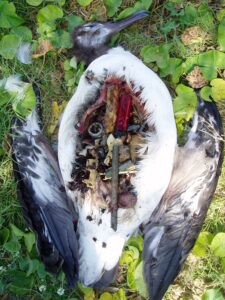Why mIcroplastIcs are HAZARDOUS?
Many studies show that microplastics can be ingested by many animals. The most known of these are; dead birds that have been found full of plastics in their stomachs.
Studies up to now show that more than 1000 sea animals are directly affected by microparticles. (For detailed information: http://litterbase.awi.de/)
 Most polymers, for example polyethylene (PE) and polypropylene(PP), are generally considered biologically inert. Some of themonomersand oligomers used in plastic products have, however, been shown toleach during usage and have subsequently been found in humans. Commonly mentioned examples are bisphenol A (BPA), a monomeric building block of polycarbonate (PC), but also used as an additive in other plastics, and styrene, used in the production of polystyrene (PS) which is commonly used in styrofoam packaging. Both of these monomers are suspected endocrine disrupting chemicals (EDCs). BPA is one of the relatively few chemicals associated with plastics that have been studied extensively and it has repeatedly been reported in urine,blood, breast milk and tissue samples. The main exposure pathways are considered to be inhalation, dermal contact and ingestion and there is a growing body of evidence that many of the additional monomers, oligomers and chemicals related to plastics can adversely affect humans, with exposure being correlated to e.g. reproductive abnormalities.
Most polymers, for example polyethylene (PE) and polypropylene(PP), are generally considered biologically inert. Some of themonomersand oligomers used in plastic products have, however, been shown toleach during usage and have subsequently been found in humans. Commonly mentioned examples are bisphenol A (BPA), a monomeric building block of polycarbonate (PC), but also used as an additive in other plastics, and styrene, used in the production of polystyrene (PS) which is commonly used in styrofoam packaging. Both of these monomers are suspected endocrine disrupting chemicals (EDCs). BPA is one of the relatively few chemicals associated with plastics that have been studied extensively and it has repeatedly been reported in urine,blood, breast milk and tissue samples. The main exposure pathways are considered to be inhalation, dermal contact and ingestion and there is a growing body of evidence that many of the additional monomers, oligomers and chemicals related to plastics can adversely affect humans, with exposure being correlated to e.g. reproductive abnormalities.
One group of chemicals that is commonly used as additives in plastic consumer products are phthalates such as di-n-octyl phthalate (DnOP)and di (2-ethylhexyl) phthalate (DEHP). Phthalates are associated with a wide range of health effects in animals and humans, and due to their extensive use they are often found in urine and blood samples from humans (Hauser and Calafat, 2005).Phthalates have been associated with developmental anomalies; it has for instance been shown to affect pubertal development, male and female reproductive health, pregnancy outcomes and respiratory health.
The most comprehensive reference book on the plastic waste trade published
Title: Plastic Waste Trade A New Colonialist Means of Pollution Transfer Editor: Sedat Gündoğdu...
Scientists from our group warn that plastics used for medical treatment cause a neglected direct human microplastic exposure
A new study has revealed the presence of microplastics (MPs) in hypertonic fluid solutions, a type...
New Study: Plastic Waste Trade: The Hidden Numbers
Plastics are a mixture of fossil fuels and chemicals, and many chemicals in plastics are known to...
Contact Us



